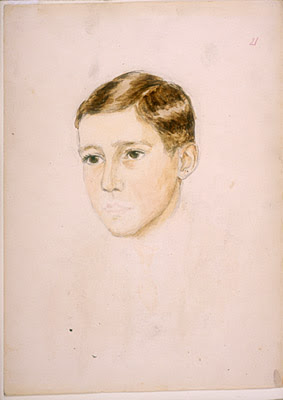 |
| Malvina Schalková, Elderly Deportee, Terezin, 1943, soft pencil 11x16 in. Ghetto Fighters' House |
 |
| Malvina Schalková. Terezin scene |
 |
| Malvina Schalková. Terezin scene |
Remembering Terezin Artist Malvina Schalková (born February 18, 1882)
by Samuel D. Gruber
Today is the birthday of Czech artist Malvina Schalek, or Schalková, one of the many artists who resisted ghetto incarceration by making art. She was already an established artist long before the deportation to Terezin. Schalková was among the older Jewish prisoners, and she was certainly an elder among artists. According to Dr. Catherine Stodolsky, she was born in Prague to a German-speaking Jewish intellectual family active in the Czech national movement. She went to school in Prague, Vrchlabi (Hohenelbe), and then studied art in Munich at the Frauenakademie in Munich (The Women’s Academy), after which she moved to Vienna and continued her art studies with the well-known woman artist Hasek-Rosenthal. She made her living as an artist, working in a studio above the Theater an der Wien, where she had many portrait commissions from Vienna's upper class. Fewer than three dozen works from this period are known to survive.
In July 1938, the Nazi annexation of Austria forced her to flee to stay with her brother, a judge and the head of the district court, in Litoměřice (Leitmoritz). She left her paintings behind but brought her aunt Emma Richter, whose son Oswald, a lawyer for the Socialist Party, was tortured and later murdered in Buchenwald for his political activities. Schalková and her brother were later deported to the Terezin (Theresienstadt) ghetto on Transport W from Prague on February 8, 1942. At Terezin she produced many drawing and watercolors portraying fellow inmates and their life there, or which more than 100 survive. she was transported to Auschwitz Transport Eb, on May 18, 1944, and died there in September 1944.
 |
Malvina Schalková, Interior. 1920. |
 |
Malvina Schalková. Self-portrait. Before 1942. |
 |
| Malvina Schalkova. Self-portrait, pencil, 1944. Yad Vashem. |
More than 100 of her drawings and watercolors survived her deportation and death, and were recovered after the liberation of Terezin on May 8, 1945. They comprise one the most comprehensive collections of victim's art from the Terezin, or an ghetto or concentration camp, and are memorable for their artistic quality and their historic value. Today, most of Schalková artworks are in the art collection of the Ghetto Fighters' House museum at kibbutz Lohamei HaGeta'ot in Israel.
 |
| Malvina Schalková. Terezin scene. |
 |
| Malvina Schalková. Terezin scene. |
 |
| Malvina Schalková. Terezin scene. |
 |
| Malvina Schalková. Terezin scene. |
 |
| Malvina Schalková. Terezin scene. |
 |
| Malvina Schalková. Terezin scene. |
 |
| Malvina Schalková. Terezin scene. |
 |
| Malvina Schalková. Terezin scene. |
 |
| Malvina Schalková. Terezin scene. |
 |
| Malvina Schalková. Terezin scene. |
 |
| Malvina Schalková. Terezin scene. |
 |
| Malvina Schalková. Terezin scene. |
 |
| Malvina Schalková. Terezin scene. |
 |
| Malvina Schalková. Terezin scene. |
 |
| Malvina Schalková. Terezin scene. |
 |
| Malvina Schalková. Terezin scene. |
 |
| Malvina Schalková. Terezin scene. |
 |
| Malvina Schalková. |
 |
| Malvina Schalková. Terezin scene. |
 |
| Malvina Schalková. Terezin scene. |
 |
| Malvina> Schalková. Terezin scene. |
 |
| Malvina Schalková. Terezin scene. |



2 comments:
You might be interested in seeing a beautiful series by the Israeli artist Ruth Kestenbaum Ben-Dov that interacts with the persona of the artist.
https://ruthkben-dov.com/the-painter-and-the-hassid/
SNF - Thank you for this link! I will look at this art closely and learn more about the artist. I look forward in using it in my class next fall, too. Thanks again!
Sam Gruber
Post a Comment